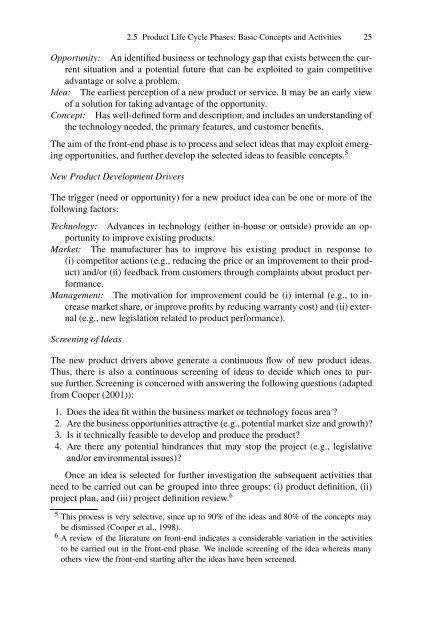9781848002708-c1
You also want an ePaper? Increase the reach of your titles
YUMPU automatically turns print PDFs into web optimized ePapers that Google loves.
2.5 Product Life Cycle Phases: Basic Concepts and Activities 25<br />
Opportunity: An identified business or technology gap that exists between the current<br />
situation and a potential future that can be exploited to gain competitive<br />
advantage or solve a problem.<br />
Idea: The earliest perception of a new product or service. It may be an early view<br />
of a solution for taking advantage of the opportunity.<br />
Concept: Has well-defined form and description, and includes an understanding of<br />
the technology needed, the primary features, and customer benefits.<br />
The aim of the front-end phase is to process and select ideas that may exploit emerging<br />
opportunities, and further develop the selected ideas to feasible concepts. 5<br />
New Product Development Drivers<br />
The trigger (need or opportunity) for a new product idea can be one or more of the<br />
following factors:<br />
Technology: Advances in technology (either in-house or outside) provide an opportunity<br />
to improve existing products.<br />
Market: The manufacturer has to improve his existing product in response to<br />
(i) competitor actions (e.g., reducing the price or an improvement to their product)<br />
and/or (ii) feedback from customers through complaints about product performance.<br />
Management: The motivation for improvement could be (i) internal (e.g., to increase<br />
market share, or improve profits by reducing warranty cost) and (ii) external<br />
(e.g., new legislation related to product performance).<br />
Screening of Ideas<br />
The new product drivers above generate a continuous flow of new product ideas.<br />
Thus, there is also a continuous screening of ideas to decide which ones to pursue<br />
further. Screening is concerned with answering the following questions (adapted<br />
from Cooper (2001)):<br />
1. Does the idea fit within the business market or technology focus area ?<br />
2. Are the business opportunities attractive (e.g., potential market size and growth)?<br />
3. Is it technically feasible to develop and produce the product?<br />
4. Are there any potential hindrances that may stop the project (e.g., legislative<br />
and/or environmental issues)?<br />
Once an idea is selected for further investigation the subsequent activities that<br />
need to be carried out can be grouped into three groups: (i) product definition, (ii)<br />
project plan, and (iii) project definition review. 6<br />
5 This process is very selective, since up to 90% of the ideas and 80% of the concepts may<br />
be dismissed (Cooper et al., 1998).<br />
6 A review of the literature on front-end indicates a considerable variation in the activities<br />
to be carried out in the front-end phase. We include screening of the idea whereas many<br />
others view the front-end starting after the ideas have been screened.



